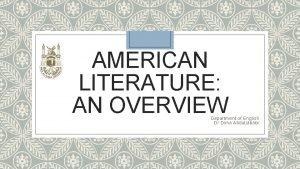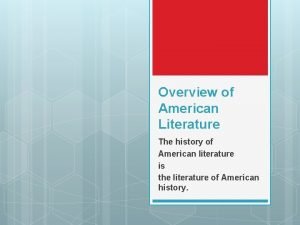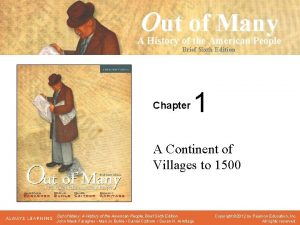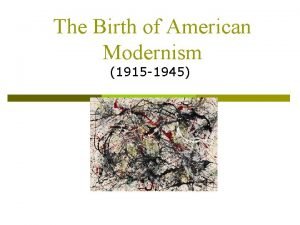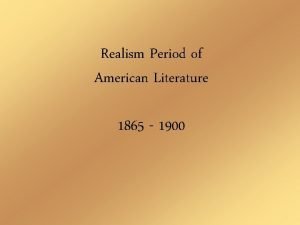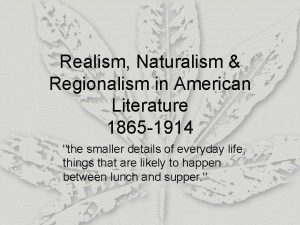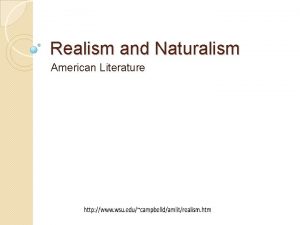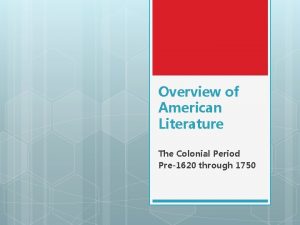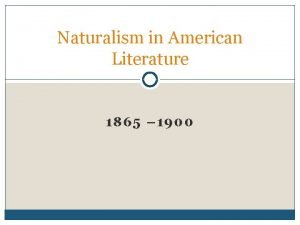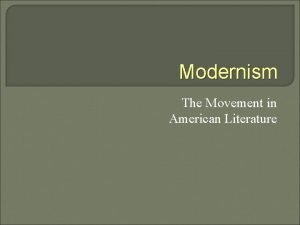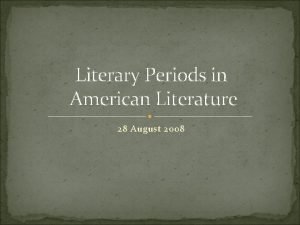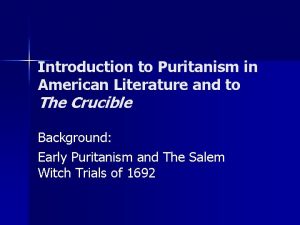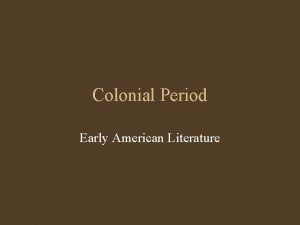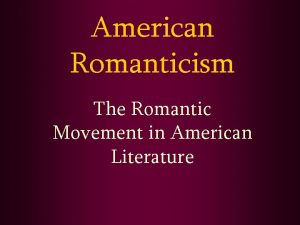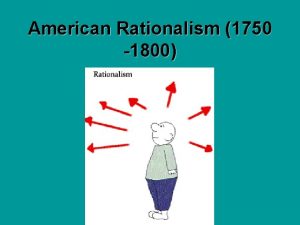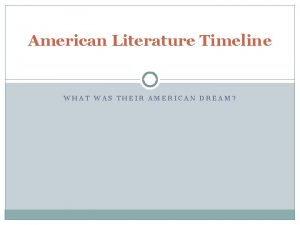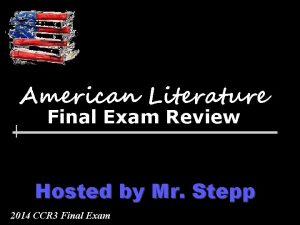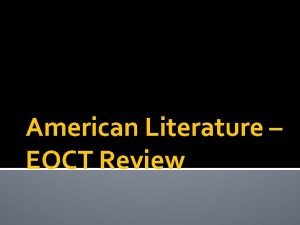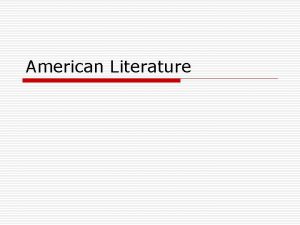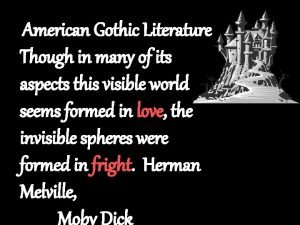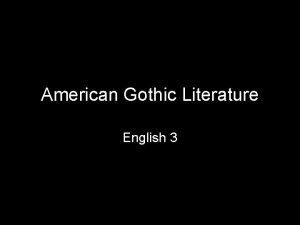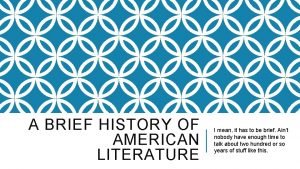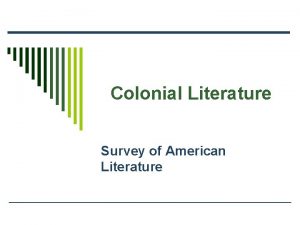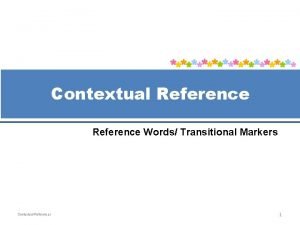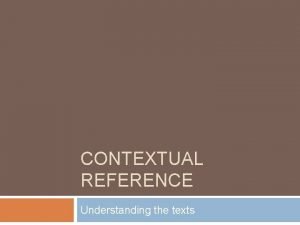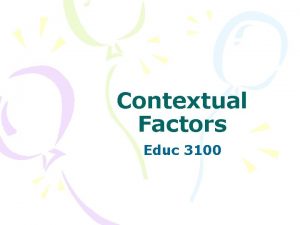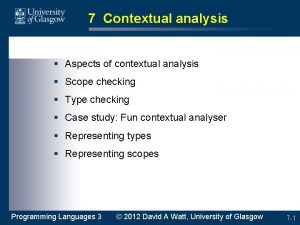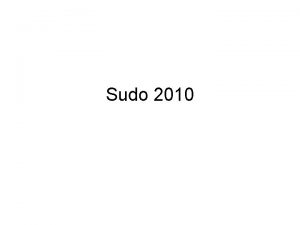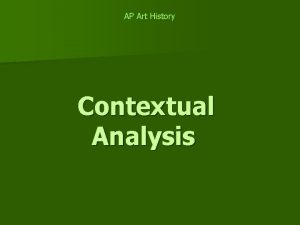Contextual overview of American Literature There are many


























- Slides: 26

Contextual overview of American Literature

There are many different literary movements in American Literature and some disagreement about when those movements begin and end. And that’s probably because there’s so much crossover! Rather than get hung up on too many specifics, I’m going to provide an overview that deals with what I feel are the major events, concerns and themes which will enable you to better answer the contextual element of your exam texts (1880 1940).

Pre 1600 s: There are no written accounts before colonisation. The Native Americans had an oral tradition (stories, songs and rituals) with mainly creation stories, myths & trickster tales. There was a focus on the natural world as sacred and the importance of land/place.

The idea of ‘America’ as an exceptional place of endless possibilities existed in the European mind well before America was ‘discovered’. The landscape of the new world lent itself to that idea. Landscape with Charon Crossing the Styx (circa 1515 1524) by Flemish artist, Joachim Patinir

1600 s to mid 1700 s: With the help of native Americans, newly arrived colonists (English, Dutch, French, Germans, Swedes, etc) created settlements. Colonists had many reasons for leaving Europe and coming to the New World, e. g. economic reasons or escaping instability. But most came for religious freedom. There is an enormous displacement of Native American civilisations as colonists move westward. The First Thanksgiving at Plymouth (1621) by Jennie Augusta Brownscombe in 1914

Literature was dominated by Puritans who cherished moral and spiritual advice and were suspicious of anything that was only for pleasure or distraction; they believed in hard work & simple no frills living. Writing (sermons, diaries, histories, scientific observation) was simple, direct and instructive with the Bible being the most important text. Although prose fiction was distrusted, captivity narratives became popular as they allegorically fit with the Puritan belief of being a chosen people defeating ‘satanic’ forces.

Mid 1700 s to early 1800 s: Colonial America welcomed crates of English books with every boat that arrived. ‘American’ writing starts to focus on service to ‘man’ (society) rather than ‘God’. Travelogues are very popular – explorers’ accounts of this new world will have made fascinating reading. Individualism and self reliance are celebrated (as is social achievement); it developed from immigrants’ desire to escape government oppression in the ‘Old World’. It’s therefore no surprise that two of the most important works of prose in the 18 th century are autobiographies. In tales, the immigrant is respected and admired more for his handiworks than for the antiquity of his family. However, there’s a divide between those seeking frontier life (seen as a place of self discovery/morally superior to the East) and drawing room civilisation.

Literature now has an ornate writing style (literacy seen as a sign of status); there’s an emphasis on reason and common sense rather than faith alone (this coincides with the rise of science & philosophy). Much of the writing is highly political, philosophical and patriotic. These writings contributed, in part, to the American Revolution. Subsequent to America’s declaration of independence in 1776, writers pondered what it meant to be ‘American’. The Declaration of Independence The ‘American hero’ appears battling against ‘savages’, nature, the Brits, etc. but there’s also a steady flow of sentimental domestic fiction, largely written by women. American explorer and frontiersman Daniel Boone whose exploits made him one of the first folk heroes of the United States.

1830 to 1860 s: This is the ‘romantic/ transcendentalist’ period where you can start to identify an ‘American literature’ – there’s a blossoming of novels, short stories & poetry; it’s often referred to as the ‘American Renaissance’. There’s a celebration of the common man & civilisation is seen as a corrupting influence. The industrial revolution is taking place and there’s a surge in the urban population. Tales of American greed & growing moral decay begin to surface (the slavery issue, treatment of native Americans, rich/poor divide, etc). Much of the writing becomes symbolic and often entails a desire to escape from unpleasant realities. In contrast to rationalism, it explores the ‘self’ and the irrational; it looks ‘beyond’. There’s an emphasis on emotions, psychology and nature. Illustration from Edgar Allan Poe’s gothic poem, The Raven.

1861 1865: American Civil war. It was a war between the north and the south. There were three problems that led to the civil war: 1) slavery 2) economic tariffs 3) states' rights. The war left about 750, 000 people dead (that would translate into about 7. 5 million US deaths in proportion to America's current population). After the civil war ended, the 13 th Amendment was passed, which freed about 4 million African American slaves. Photograph from the Gettysburg battlefield (July 1863).

Attention turned to westward expansion, which diverted attention away from the recent war and there was also a shift towards the development of industry and technology. America now has 2 contrary images of itself: pioneer land vs skyscrapers & labourers toiling away in factories.

Subsequent to the civil war (latter half of the 1800 s), there’s a move to realism, which conveys the reality of life (romanticism is seen as too idealistic). Its focus was the place of change: the modern city, business & politics, the changing regions, etc. There’s usually an objective narrator (they tend to ‘show’ rather than ‘tell’). Participants in the war had recorded their experiences and this resulted in a new plainspokenness in literature. Part of this realism was regional writing or local color as it’s sometimes called, which became popular and dominated literature even into the start of the 20 th century. It aimed to capture the peculiar flavour of regions, dialects, customs and landscape and started to give voice to the voiceless/vulnerable (immigrants, blacks, women); it celebrated simple life. It’s sometimes seen as a rejection of the genteel tradition, which emphasised ‘Victorian’ values in social, moral, and literary standards. In 1884, Mark Twain wrote The Samuel Langhorne Clemens (Mark Twain) Adventures of Huckleberry Finn.

Late 1800 s to early 1900 s: Naturalism (connected to realism) focuses on the grim side of life where man (usually from an underclass and ruled by heredity, instinct and passion) struggles to adapt to an indifferent, sometimes hostile, environment (nature, harsh social contrasts, racism, wage slavery, etc. ) where morality has no place. ‘Civilisation’ is shown to be corrupt, which fit nicely with the muckraking spirit (investigative journalism) of this period, which, like literature, pressed for social reform. Mine workers begin their protest march in 1897; 19 were later killed by the police.

About 1912 to mid 1900 s: Let’s deal with 1912 to 1929 first – different ways of seeing the world (Darwin, Marx, Nietzsche & Freud) as well as European experimentation with the arts had come to America. But the following also occurred: WW 1, the ‘red scare’, isolationism, xenophobia, racism, prohibition, women’s suffrage, the ‘roaring 20 s’, lots of technological changes (car, telephone, etc. ), mass consumerism, the rise of youth culture, fear of eroding traditions. There was a clear tension between nostalgia and novelty. Writers often withdrew to Europe to separate themselves from a culture that was seen as Puritanical and materialistic. They wanted to ‘make [literature] new’; we see a creative adventure with unreliable narrators, stream of consciousness, fragmented structures, frequent use of irony/understatement. This is the modernist period where there are themes of waste, alienation, futility, a questioning of the world, existential crises. There is also the rise of female writers, the Harlem Renaissance and the Southern Renaissance. It was in this modernist period that Fitzgerald wrote The Great Gatsby (1925).

Then comes the Great Depression of the 1930 s. We see mass unemployment, bread lines, urban misery and rural decay. In literature, the political order is challenged with radical, often Stalinist views put forward in the hopes of achieving a classless society.

And that’s all that you really need for your exam (1880 1940). However, you may wish to know where it leads so I’ll briefly try to explain what’s referred to as post modernism. 1945 ? ? ? WWII (and knowledge of the holocaust), fear of communism, America’s rise to world influence, military expansion, the Cold War (with the threat of nuclear annihilation) – it’s an “Age of Anxiety”; the radicalism of the 1930 s now found itself out of touch with the new climate particularly with the Mc. Carthy witch hunts. It was also the age of the media, further technological progress (e. g. space exploration) and unprecedented prosperity. However, social protests (civil rights, women’s rights, gay rights) took place. The decades might be summed up (somewhat unfairly perhaps) as the affluent 50 s, the liberated, drug culture of the 60 s and the narcissistic 70 s. Boundaries are blurred and popular culture becomes a driving force in literature and art. In terms of literature, there’s an eclectic mix of styles: spontaneous, critical, (darkly)ironic, satirical, intertextual, surreal, violent, apocalyptic, obscene. There’s a mixing of forms, styles and genres and language tends to draw attention to itself. Post modernism often exposes the absurdities of daily life. There’s also a questioning of ‘traditional values’, suggesting that values (as well as ‘realities’) are created by the media / oppressive forces. Interpretation is everything as ‘reality’ means nothing without quotation marks. A supposedly egalitarian society is addressed through gender and race issues. There are no real heroes; anti heroes are common. It’s often detached/unemotional and individuals seem isolated/powerless in an uncaring world. There are crises of identity and a ‘vacancy of meaning’ in life. We see fragmented structures but unlike modernism, the narratives tend not to have a ‘neat ending’. Many suggest that post modernism has ended (dates differ) but there’s no agreement on what followed: postmodernism? A return to realism? Magic realism? What do you think?

Major themes in American Literature

The next fives slides are something have been put together by an American teacher for his/her high school class. It’s a useful starting point when considering some of themes.

The Journey from Innocence to Awareness Undoubtedly, this theme can be found in the literature of any country, not just America. Most stories are, at their core, about such a journey. Think of almost any novel you’ve read in or out of school; think of the main character. It is very likely that this character encountered experiences that changed him or her in some significant way. Most probably, by the end of the novel or play, the character was a different person than he or she was at the beginning. In American literature, this theme is everywhere. For some, this journey is ruinous; they are destroyed by the experiences they encounter. For others, the journey is rewarding; they are strengthened by their struggles.

The American Dream Though people have come to America for a variety of reasons, most have come for opportunity. From its very beginning, America has been viewed as a place where you can recreate yourself. No matter who you are, there is a sense that you can come here and become something different, something new, something better. All that is required is hard work. This has become known as the Puritan Work Ethic— the belief that in America, hard work will be rewarded. Initially defined as the ability to own property and earn financial independence, the American dream has changed over centuries, and is now more closely identified with material possessions. In American literature, however, this dream has come under close scrutiny, as writers burrow beneath the surface of accepted conventions to reveal uncomfortable truths. Again and again, writers have probed the American Dream and shown it to be little more than an illusion—hollow, deceptive, even destructive.

The Land the Frontier America was the New World, the New Eden for the early settlers. Open and fruitful, America offered the promise of paradise and the possibility of renewal. America was, and for many still is, the new frontier, untamed and unexplored, that we venture into to discover not just what is on the other side of that valley or just over that hill, but to discover who we are and what we can be. Even today, when there is seemingly no new land left to be explored, this aspect of the American character still reveals itself in our desire to take to the road. In America we move, we leave home to go to college, take a job in New York, and trek across country in a VW Bus. The road, it seems, is in our blood. In American literature, theme of the land the frontier has taken several shapes. For some writers, the land is a place of hope and renewal, as with the Transcendentalists. For others, the American frontier is a dangerous wilderness, a place of mysterious evil, as we see with Naturalism.

The Hero In America, the “I” is king. We are a nation that celebrates the individual— his achievements, her triumphs. Think of the Olympic athletes. We are more apt to remember Michael Johnson, Kerri Strug, and Carl Lewis, than the others who placed 10 th. This is because, in America, the individual reigns supreme. Indeed, the stereotypical American hero is the self made man or woman, the individual who, through hard work, initiative, and perseverance, makes his or her fortune and achieves the American Dream of success and wealth. In pop culture—movies, television, pop novels—the hero typically prevails. Wherever the hero finds himself/herself, this person is always able to overcome the odds. The hero often journeys into dangerous territory (violent neighborhoods, outer space, etc. ) and overcomes the evil that threatens us. This hero is the marshal who cleans up the town, the marine who saves the platoon. He is Luke Skywalker conquering the dark side, Will Smith or Sigourney Weaver pounding aliens into submission. In American literature, however, the hero is often altogether different. The evil he struggles against is, very often, his own society—its rigidity, its constrictiveness, its limitations, its cruelty, its prejudice. In literature of the twentieth century, the hero often fails. For unlike pop culture which comforts us and reaffirms our hopes and beliefs, literature seeks to challenge us and question our conventional view of the world.

Community Though society, as suggested above, often constricts, limits, and even destroys the individual, community often serves as the individual’s salvation. What distinguishes community from society, above all, is its size. Society is large, abstract, impersonal, a nameless force defeating our hopes and suffocating our identities. Community, on the other hand, is smaller, more specific, and more personal. It can even provide solace, love, compassion, and support. Our desire to be a part of a community is met by sharing with others our tastes in music, hobbies, religion, careers, etc. In American literature, this theme is particularly seen in contemporary multi cultural literature and in women’s literature which suggest that it is in the security of a real community, rather than in our own personal glories, where we will find a home. And because the heroes of these novels do find such a home, their journeys are very often successful ones.

OK, I’d now like to add a few more (themes that are especially applicable to American Lit); we’ll discuss these in further detail in class. Tolerance Cultural diversity (melting pot vs salad bowl theories) Religion (or the lack of it) Conflict: • Freedom vs captivity • Class vs egalitarianism • Civilisation vs the frontier • Rebellion vs conformity • Morality vs immorality • Past vs present Isolation Violence Technology?

Excluded because they’re set texts: F Scott Fitzgerald: The Great Gatsby; John Steinbeck; The Grapes of Wrath; Henry James: The Portrait of a Lady; Mark Twain: Adventures of Huckleberry Finn; Theodore Dreiser: Sister Carrie; Willa Cather: My Ántonia; Edith Wharton: The Age of Innocence; William Faulkner: The Sound and the Fury; Ernest Hemingway: A Farewell to Arms; Richard Wright: Native Son • • • • • William Dean Howells: The Rise of Silas Lapham (1885) Henry Blake Fuller: The Cliff-Dwellers (1893) Hamlin Garland: Main-Travelled Roads (1891) or Prairie Folks (1893) Stephen Crane: The Red Badge of Courage (1895) Kate Chopin: The Awakening (1899) Frank Norris: Mc. Teague: A Story of San Francisco (1899) Jack London: The Call of the Wild (1903) or White Fang (1906) Upton Sinclair: The Jungle (1906) Ellen Glasgow: ? ? ? Gertrude Stein: Tender Buttons (1913) Sinclair Lewis: Main Street (1920) or Babbitt (1922) Thomas Wolfe: Look Homeward, Angel (1929) Henry Roth: Call It Sleep (1934) Henry Miller: Tropic of Cancer (1934) James T. Farrell: Studs Lonigan trilogy (1932, 1934, 1935) John Dos Passos: U. S. A. (1937) Nathanael West: The Day of the Locust (1939)

THEMES THAT GG & HF HAVE IN COMMON “Civilised” society Captivity Loyalty / friendship Religion Family Youth Isolation Lies and deceit The motif of alcohol What evidence from Gatsby and Huck Finn could answer most/all of the above themes?
 Antigentest åre
Antigentest åre American literature overview
American literature overview American literature overview
American literature overview Out of many a history of the american people
Out of many a history of the american people The american romantic period
The american romantic period American modernist novels
American modernist novels Realism literary period
Realism literary period Realism v naturalism
Realism v naturalism Realism in american literature
Realism in american literature Realism and naturalism in american literature
Realism and naturalism in american literature American literature colonial period
American literature colonial period Naturalism in literature
Naturalism in literature Modernist literary movement
Modernist literary movement Literary movements in american literature
Literary movements in american literature Puritanism in american literature
Puritanism in american literature Periods of american literature
Periods of american literature Periods of american literature
Periods of american literature Difference between romanticism and classicism
Difference between romanticism and classicism American rationalism
American rationalism American literature timeline
American literature timeline American literature final exam
American literature final exam Common themes in american literature
Common themes in american literature Outline of american literature
Outline of american literature American gothic literature characteristics
American gothic literature characteristics Gothic elements
Gothic elements Brief history of american literature
Brief history of american literature Realism and regionalism
Realism and regionalism

